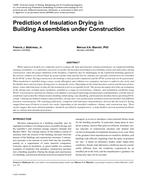
Prediction of Insulation Drying in Building Assemblies under Construction
While numerical models are commonly used to evaluate the heat and moisture related performance of completed building envelope assemblies, it is sometimes necessary to predict the moisture performance of a building system and subsystems during construction, when the proper definition of the boundary conditions may be challenging. In the traditional modeling approach, the exterior climates are chosen based on actual weather data and the interior climates are typically considered to be controlled by the HVAC system. During construction, the envelope is only partially completed, and the HVAC system may not be operational. When insulation is installed using a spray system (fiberglass and cellulose are examples), moisture is added to the cavity and the builder must wait for proper drying prior to closing the cavity. Depending on the initial moisture content and the type of insulation, it may take from hours to days for the insulation to dry to acceptable levels. The present document describes an evaluation of the drying rates of damp-spray insulation, installed in a range of constructions, climates, and installation conditions using WUFI. A set of exterior and interior climates were defined, covering a broad range of temperatures and humidities, with the interior conditions represented the climate inside a building with framing, roof, sheathing, and insulation installed, but no operating HVAC system. Utilizing the defined climates and assemblies, drying rates were predicted for insulation material installed with different moisture concentrations. The resulting predictions, compared with laboratory measurements, showed that the need for drying ranged from none (0 hours) to nearly two weeks, depending on the installed conditions, climate, and construction type. These results suggest that more detailed guidance should be provided by manufacturers, to help builders prevent potential problems due to construction-introduced moisture.
Presented at Thermal Performance of Exterior Envelopes of Whole Buildings X – December 2007
Units: Dual
Citation: Thermal Performance of Exterior Envelopes of Whole Buildings X
Product Details
- Published:
- 2008
- Number of Pages:
- 12
- File Size:
- 1 file , 3.7 MB
- Product Code(s):
- D-BldgsX209


